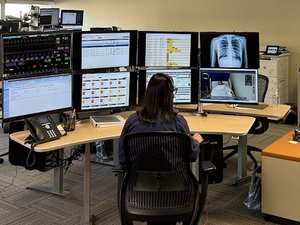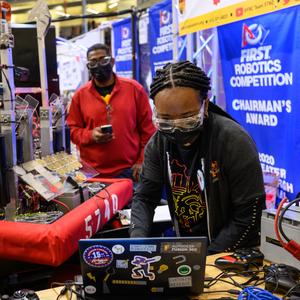Editor's note: Technological advancements, specifically those in the areas of artificial intelligence (AI) and automation, are changing the way people work — and transforming entire professions. What will the jobs of the future look like? On Dec. 13, 2023, the Pittsburgh Business Times will host “Future of AI in the Workplace,” a breakfast event to examine this very topic. The event is SOLD OUT and no walk-in registrations will be accepted.
One fish, two fish, red fish … no sight of any blue fish, at least not today.
Around and around these dishes of fish and other sushi go, parading along automated conveyor belts inside Kura Revolving Sushi Bar, a restaurant chain that opened a location on Cinema Drive in Pittsburgh's South Side last September.
The restaurant, adorned with modern Japanese aesthetics and cultural references, boasts the distinction of being the city’s first to serve sushi rolls and nigiri as well as other Japanese delicacies via a conveyor belt system, whose ambient hum blends with casual conversation.
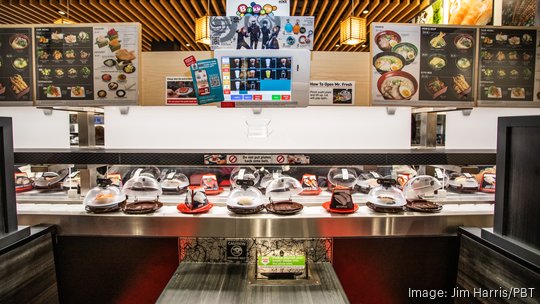
Two robots affectionately named Kirby gracefully navigate the front-of-house floor and assist the five or so servers who also cater to the restaurant’s 38 tables and bar area, creating what appears to be a harmonious synergy between human and machine. These robotic helpers deliver drinks and special dishes that don’t fit on the conveyor belt’s tracks, which serve dozens of dishes at a price of $3.65 per plate.
Those wishing for a menu item they don’t see cycling on the lower conveyor belt can send a request for it to the kitchen directly via a touchscreen above the table. Within minutes, the order comes skirting across an express-like upper conveyor belt that brings it right to the customer.
For some of the waitstaff, the aid of the robotic helpers has come as a welcome addition.
“From my experience, because I’ve served before, it makes [the job] a lot less stressful because we’re putting some of the burden onto the technology so we can focus more on the hospitality and the guest,” Kaylee Micklow, one of Kura’s wait staff members, said. “It helps us out.”
Micklow said not having to juggle as many tasks at once, as she has done before at other restaurants, is a benefit to workers and customers.
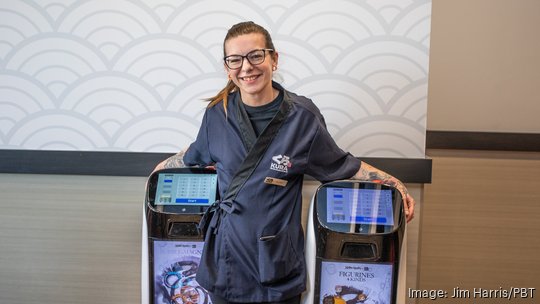
While these conveyor belt delivery systems have existed at restaurants in Japan and replicas of them in other countries for years, the use of this automation and the assistance of the two Kirby machines are helping to paint a modern picture of what working with artificial intelligence, robotics and automation looks like today and provides a glimpse into where it’s going.
It also comes as wider concerns grow regarding the impact AI and robotics might have on employers and employees, too.
The Artificial Intelligence Policy Institute (AIPI), a research and advocacy nonprofit, found that 1.4 million jobs in Pennsylvania “have significant exposure to AI automation,” where it estimated that over 25% of tasks these jobs require can instead be automated using existing technologies. This analysis looked at jobs across industries and found office and administrative support jobs, legal work and operations jobs in business and finance as likely to be the most affected.
“While in the long-term technology can create new jobs, job loss due to automation in the short-run threatens to create a major turmoil for millions of regular Americans,” Daniel Colson, executive director of AIPI, said in a statement. “We hope that by connecting AI’s rapid development to the potentially ground-altering effects on the labor market, policymakers will take decisive actions to prepare for this imminent reality.”
What all this means for Pittsburgh’s workforce is hard to predict, but the impact these technologies will have is already well underway.
Seismic shifts
The study of technology-induced job displacement and job destruction has been occurring “since forever,” according to Christopher Briem, a regional economist at the University of Pittsburgh Center for Social and Urban Research.
In cities such as Pittsburgh, where a not-so-long-ago history of significant job loss remains in the memory of many, understanding this context is essential when evaluating the potential impact AI and robotics might bring to the workforce, especially as companies position these tools to address workforce gaps.
Take for instance the coal industry or the telephone switchboard operator, sectors Briem said once employed large portions of the region’s population. The former saw the adoption of automated conveyors and carts to bring the extracted sediment up to the surface in lieu of teams who used to perform such work, while the latter has since been long forgotten as a career path due to automated systems that rendered such jobs obsolete decades ago.
“There’s nothing new about the challenge of technology coming in and displacing workers,” Briem said. “Hopefully the goal is there’s more value added, and [workers] should be getting a higher wage in the end. … The question is what happens to workers who are displaced either too rapidly or [due to being] too concentrated in one location to shift into other work.”
The current advancements in the workforce are coming at a time when the Pittsburgh MSA has seen a decline in its labor count since the pandemic’s onset. Per the most recent data available from the Pennsylvania Department of Labor & Industry, the Pittsburgh MSA had an estimated labor participation force — the number of people 16 years old or older who are either working or actively seeking work as a share of the total working age population — of 1,170,400 in September 2023, a decrease of about 42,500 since September 2019. It’s a reduction that’s bucking national trends and those of several other peer cities, where the labor force participation rate has continued to recover post-pandemic.
Michael Madison, a professor of law and John E. Murray Faculty Scholar at Pitt, spoke against a popular framing of AI, robotics, automation and tech more broadly being used to fill gaps like these and argued instead that these tools will continue to grow in influence as it relates to aiding workers. His favorite example of this is seen with video-assisted refereeing, which has become mainstream in nearly all professional sports over the years.
“You have instant replay with football and basketball and tennis and golf and lots of sports,” Madison said. “The automated refereeing is not fully automated; it’s an automated add-on to human refereeing.”
This type of automation isn’t limited to professional sports, of course, and as of late has come to infiltrate numerous facets of the economy. And it’s not just affecting low-level, easily automated or scripted jobs, either, he stressed. It has since proliferated into highly sophisticated fields ranging from the medical sector to creative industries like art and music.
“The group of people who I keep hearing about who are the most anxious about their future careers being disrupted by generative AI are graphic designers,” Madison said. “Go to Stable Diffusion, go to Midjourney, go to the visual arts generating machines, and many people can tell the difference between an AI-generated work of art and a human-generated work of art. But it’s getting harder, and the AI systems are generating really imaginative, creative stuff.”
Music composition also is susceptible to this, though “you’re not going to be able to get a machine to generate a song that is as catchy or as memorable or as moving as something like Taylor Swift could produce,” he said.
When it comes to AI and more specifically generative AI, Madison and Briem both suggested that workers across career paths find ways to become educated about these tools and, if relevant, learn how they can be implemented into their own jobs.
This will hold especially true if, as Madison predicts, AI and automation continue to permeate into work and life as the boundary between what is and isn’t being labeled clearly as AI fades away, like the toggling of using AI while searching on Google.
“Very soon that special AI button is going to go away and you’ll just have AI baked into our baseline experience of Google; that’s one example,” Madison said. “You’ll have it in your Apple Watch, you’ll have AI in your smartphone, you’ll have AI in Google, you’ll have AI in the basic suite of tools or devices or systems that you use for whatever you do, whether you’re a musician or a lawyer or a warehouse worker or a barista or delivering newspapers.”
AI progresses forward
For some companies, especially tech firms established since the 2010s, the use of AI and machine learning algorithms already have been embedded into the business’ core.
Since its founding in 2011, Duolingo Inc., an East Liberty-based edtech company known for its popular language-learning platform, has gathered various data points from the people who use its platform to measure their performance while they are learning a given language, which Duolingo can then use to serve up the most appropriate lesson the next time someone returns to the platform, automatically increasing or decreasing the difficulty of courses at an individual level.
But advances in computational power and a recent partnership with OpenAI Inc. now permit Duolingo’s curriculum content creators, called learning designers, to use generative AI tools for the development of course materials for languages that have been lacking in robust content for a long time, content Bozena Pajak, vice president of learning and curriculum at Duolingo, said might not have come to certain languages like Romanian on the platform for many years, if ever.
“We’re very excited because a lot of our courses still offer just a pretty limited amount of content, and we really want all our language courses to get learners to a pretty advanced level,” Pajak said. “I think we’ll be able to actually get there for most of our courses in the next couple of years, which is amazing. Without this technology, this would have just been completely impossible.”

It’s also allowing this team of about 40 people out of a company that employs around 600 to pursue more nuanced tasks. Because of AI, Pajak said Duolingo’s learning designers have overseen the production of more content this year than they have in the past two years combined, and Duolingo is hiring more workers for this department to keep up with all this additional content creation.
“Our learning designers, they are definitely not going anywhere. They are essential to figuring out how to use AI to actually create what we want,” Pajak said. “Our learning designers basically have been shifting from doing a lot of the more manual work of writing and reviewing content to figuring out how to do that with AI.”
A lot of these efforts, Pajak said, involve prompt engineering — working on the inputs given to a generative AI tool to fine-tune its outputs. Existing skillsets these learning designers already possess from prior teaching experience or from natural analytical thinking abilities have proven invaluable for these efforts, she said.
“These skillsets turn out to be very helpful when working with AI because you need this analytical thinking, being able to articulate what is it that we need, what are the key pieces in our pedagogy,” Pajak said. “I feel like the skillsets, really we’re not changing that in terms of how we’re hiring, but the job responsibilities have changed.”
As Duolingo incorporates AI for language-learning efficiency, it reflects this broader trend of technology reshaping work dynamics. But this AI integration isn’t exclusive to digital learning platforms; it extends across industries.
In October, Gecko Robotics Inc. — a developer of robots capable of scaling and scanning large infrastructure assets like military warships or oil tank reservoirs — announced the launch of its Cantilever product that, with the power of AI, allows its customers to have easier access to analysis and tools that can aid in repair-related decision-making.
Jake Loosararian, CEO and co-founder of Gecko, has described Cantilever as “the primary operating system for the physical world.” The product has been a working concept that dates back to Gecko’s origins nearly a decade ago but one that could only be realized now given advancements in computational power, machine learning algorithms and AI.
“[It’s] a software that is able to actually take this arbitrage of mastering damaged things in the built world and actually creating the first instance of a predictive maintenance software tool that helps customers to see exactly what’s going to fail and why and what to do to prevent things from failing,” he said.
Gecko, which employs about half of its 260-person workforce out of its North Side headquarters, started Cantilever’s development with a team of about a dozen people. The team has since grown to consist of about 50 workers.
This combination of AI and robotics as an industry-aiding tool is also one that autonomous vehicle developer Aurora Innovation Inc. is looking to provide in the near future as well.
On Sept. 13, Chris Urmson, CEO and co-founder of Aurora, testified before the U.S. House Committee on Transportation and Infrastructure as part of a discussion centered on the accomplishments of AV technology and where it might be heading in the years to come. For Aurora, a company that has about half of its 2,000-person workforce based out of its Strip District headquarters, developing trucks that can drive themselves on busy freight corridors is an effort that could become reality by the end of 2024.
During his testimony, Urmson stressed that this feat won’t lead to the replacement of truck drivers but rather one that aims to fill an industry gap, a gap that the American Trucking Associations estimated reached 78,000 people nationwide in 2022 and could double by 2031.
Urmson also said this technology isn’t going to be fully capable of self-driving for every scenario upon its launch, like for last-mile deliveries in urban settings, as the technology is still years out from reaching such a level of maturity.
“We don’t see this as a big-bang deployment all at once; we expect this technology to roll out incrementally,” Urmson said while noting the company is starting with long-haul trips on interstates as it prepares to launch on its testing corridor between Dallas and Houston.
New jobs and roles for robots
Meanwhile, robots in various forms have continued to advance into the service industry, shipping and logistics, agriculture and construction over the past year, all feats well beyond the origin days of machines that started out performing much simpler tasks on manufacturing assembly lines a few decades ago.
“The intersection between AI and robotics has been, I think, super important, and it’s going to really dictate where the field is headed in the next 10, 15 years,” Matthew Johnson-Roberson, director of the Robotics Institute at Carnegie Mellon University, said during CMU School of Computer Science’s Virtual AI Media Day on Oct. 24. “I think we’re at the precipice of a very new era.”
Take for instance the fleet of four automated robots Pittsburgh International Airport purchased in March 2021 from Lawrenceville-based Carnegie Robotics, which roam and sanitize the airport’s terminals. These machines allow cleaning crew staff, who work in a broader industry that has struggled to recruit and retain workers amid, according to job board and placement firm Zippia, a reputation of low wages and poor benefits to focus on other areas that require a finer touch like bathrooms or narrow corridors.
“The data generated from the cleaners, in concert with other data sources we have, give managers and ops personnel new insights that help with benchmarking, monitoring, assignments and contribute to a cleaner, more consistent airport environment,” Bob Kerlik,director of public affairs with the Allegheny County Airport Authority, said.
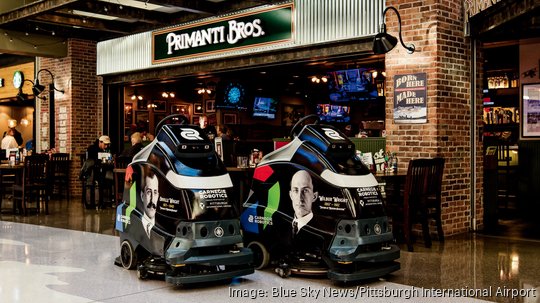
In addition, numerous Pittsburgh-based companies working with partners in the shipping and logistics industry, like Seegrid Corp. and Thoro.ai, have picked up warehouse customers over the past few months to expand the deployment of autonomous pallet movers, which are helping workers transport more inventory throughout a sprawling job site more quickly than before. And last March, Advanced Construction Robotics Inc. launched its IronBOT product, a co-working companion to its rebar-tying TyBOT, which can work in tandem with one another and with construction crews at sites across the nation to aid workers with the placement and installation of heavy materials.
Looking ahead, Johnson-Roberson outlined the shift in robotics toward building multi-modal models, incorporating speech, images and video data for these machines to take on to enhance robots’ adaptability in the real world. It’s an ongoing effort that has seen rapid progress over the past three years, he said.
Despite these advancements, Johnson-Roberson said essential questions for widespread robot adoption still need answers that address the speed, flexibility, safety and potential for cost savings in workplaces.
“One of the big concerns and I think a real thing that we have to reckon with as technologists in this area is what is going to be the impact on society if we do solve a lot of these problems and end up displacing some jobs,” Johnson-Roberson said. “I don’t think everyone needs to become a programmer. I don’t think everyone needs to become a roboticist. But I think it is about staying open to learning. I think that’s one of the most critical pieces.”
Automation: Great until it’s not
Back at Kura, Micklow and her other servers watch a large screen that displays a table’s number if a customer needs human-required assistance for a task that Kirby can’t quite accomplish.
This could be anything from a drink refill — Kirby can only bring out new beverage orders due to health and sanitary practices — or replacing a pair of chopsticks that have fallen on the floor.
But sometimes a toy reward that dispenses from above each table gets stuck, an activity that occurs once a customer puts 15 plates into the automated retrieving slot, and an employee has to remedy the jam or offer an alternate prize at the front.
And then there’s the payment process, which usually can be accomplished in a self-checkout manner by scanning a QR code on the table’s touchscreen with a smartphone. But that service goes down sometimes or runs into compatibility issues between smartphone operating systems, leading customers to more traditional payment methods via cash or card.
Oh, and then there’s Kirby, who can get a little lost sometimes and was caught delivering an ordered iced tea about five tables too early.
“It’s frustrating whenever it does mess up, but you get that,” Micklow said. “Technology’s great until it’s not.”
Understanding AI systems and how they’re used
Artificial intelligence, the use of computers and machines to perform tasks that would typically require human intelligence, is reshaping industries and consumer experiences alike, though it's a broad technological term that can come in many forms. Here's a brief look at key AI terms as it relates to the ones that are popular among businesses and consumers:
Machine Learning (ML): Data-driven decision making — ML analyzes vast datasets, helping people optimize processes and make data-driven decisions that can also lead to personalized recommendations, which can be seen in streaming services and e-commerce platforms.
Natural Language Processing (NLP): Seamless interactions — NLP enables computers to understand and interpret human language in the various ways that humans speak, which can lend itself useful when it comes to customer service chatbots and virtual assistants. Voice-activated smart assistants like Siri and Alexa exemplify NLP in action as well.
Computer Vision: Visual data analysis — With computer vision, machines can interpret and make decisions based on visual data. It is used for facial recognition, quality control and augmented reality applications.
Generative AI: Creative computing — Generative AI automates content creation, impacting marketing and social media primarily but with a use case that's constantly evolving given the ability these tools like text-based ChatGPT and image-based Midjourney have at creating written and artistic-based content, respectively, in all sorts of forms.




